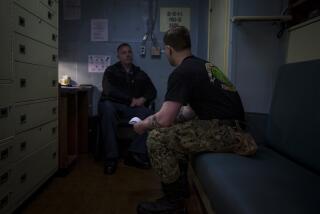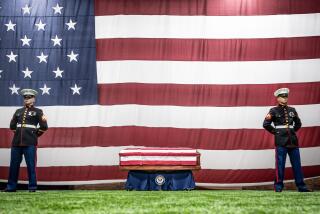Family of Fallen Seabee Finds Solace and Pride
- Share via
The televised tragedy gripped the nation and shattered a family.
*
Gun-wielding terrorists hijacked a TWA airliner to Beirut and singled out Robert Dean Stethem because he was carrying military identification.
The Shiite Muslim extremists repeatedly beat him as a way to intimidate the other 152 passengers. When their demands for more jet fuel were refused, they shot him in the head and dumped his broken body on the Tarmac.
The memory of the lone fatality in the 1985 hijacking was immortalized Saturday, when the Navy’s newest Aegis guided missile destroyer was commissioned as the USS Stethem.
For the Stethem family, the ceremony was more than the official acceptance of the sleek warship into the U.S. fleet. It marked another attempt to fill a hole in their lives and dress a wound that refuses to heal.
“I wouldn’t say it has been a turning point, but it’s been a happy point in our lives since this happened to him,” said Richard Stethem, father of the fallen Seabee.
“We’ve lost part of our life that can never be brought back,” Richard Stethem said. “But this is the highest honor for somebody to have. It has made us feel awfully, awfully proud.”
The Stethem clan attended the ceremonies at the Seabee base in Port Hueneme, arriving from Maryland, Virginia and Florida.
Theirs is a family with a strong Navy tradition. Robert Stethem’s uncle was in the Navy. So was his father, who retired as a senior chief petty officer after 26 years.
His older brother, Kenneth, is a Navy SEAL and his younger brother, Patrick, followed Robert’s footsteps into Underwater Construction Team 1--a group of Virginia-based Seabee divers. Robert Stethem’s father does not want his slain son’s attributes inflated, as is often done in such tragedies.
“He was just an ordinary kid that people kind of flocked to,” Richard Stethem said. “He did his schoolwork and did what his parents told him. He liked to go out and have a lot of fun.”
His mother, Patricia L. Stethem, remembers his popularity. “Wherever there was Rob, there was fun and a little bit of devilishness going on. He had a lot of friends. I never ran into anybody who didn’t like him.”
Since his life was cut short at age 23, the petty officer second class has been awarded the Purple Heart and Bronze Star. But those medals, his parents say, cannot compare to having a $900-million destroyer carry his name--an honor often reserved for Presidents and military brass.
*
“There are not too many enlisted men who get a tribute like that,” his mother said. “It ought to make the sailors aboard appreciate that one of their own is the ship’s namesake.”
When the ship was being built, the Stethems visited the Litton-owned Ingalls Shipbuilding site in Pascagoula, Miss., shaking the hands with shipyard workers.
When the ship was christened, Patricia Stethem was selected to smash a magnum of champagne across its bow.
When the vessel first went to sea in May, the Stethems were aboard. “We stayed up 20 of the 24 hours we were on the ship,” Richard Stethem said. “We had a great time.”
The Stethems have maintained a close connection with the ship and its crew. “It’s one of the few places where you hear our name pronounced correctly,” said Richard Stethem (pronounced STEED-em).
It’s been a long, painful decade for Patricia Stethem. She knows precisely how long it’s been since she lost her son: 10 years, four months, seven days.
On June 14, 1985, Robert Stethem was headed home with five other Navy divers when their flight from Athens, Greece, was hijacked by two Lebanese Shiite Muslims.
The flight was diverted to Beirut, then Algiers, then back to Beirut and then back to Algiers and finally back to Beirut. Most passengers were released in the first two days, but 39 American men were spirited away by the hijackers into Beirut and held captive for another two weeks before being freed.
*
Stethem and another Navy diver were beaten during the first hours of the 17-day ordeal, but Stethem was the only one to lose his life.
Many details of the hijacking did not surface until the 1988-89 trial of Mohammed Ali Hamadi, one of the two terrorists. He was nabbed in 1987 for trying to smuggle explosives into West Germany.
The Stethems attended every session of the yearlong trial, which ended in a conviction for murder and air piracy. Hamadi is serving a life sentence in Germany. His accomplice remains at large.
During the trial, one passenger told of how Stethem was ready to die to save others.
“He believed that someone would die on the plane, someone from the Navy men and he said because he was the only one who wasn’t married, that he should be the one to die,” testified passenger Ruth Henderson of Australia.
Stethem had been so badly beaten that she had to hold a cigarette for him. He was bleeding from his head and back. His wrists had been tied so tightly that he had no feeling in his hands.
“He didn’t believe that all of us could get out alive,” Henderson said. “He felt it was fair that he dies so that the rest of us could live.”
More to Read
Sign up for Essential California
The most important California stories and recommendations in your inbox every morning.
You may occasionally receive promotional content from the Los Angeles Times.













